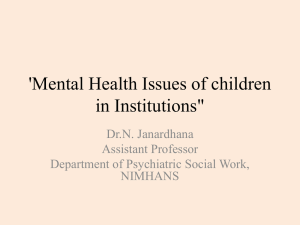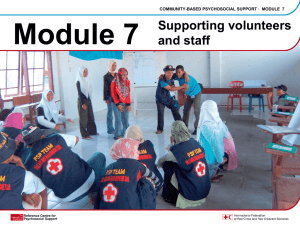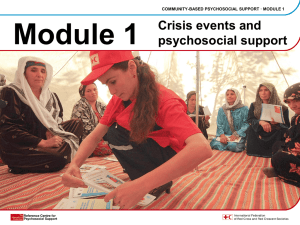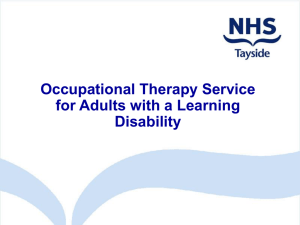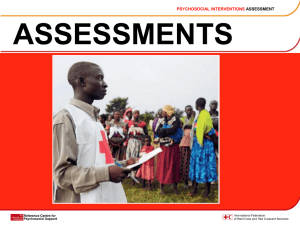PowerPoint 2: Planning - Save the Children`s Resource Centre
advertisement
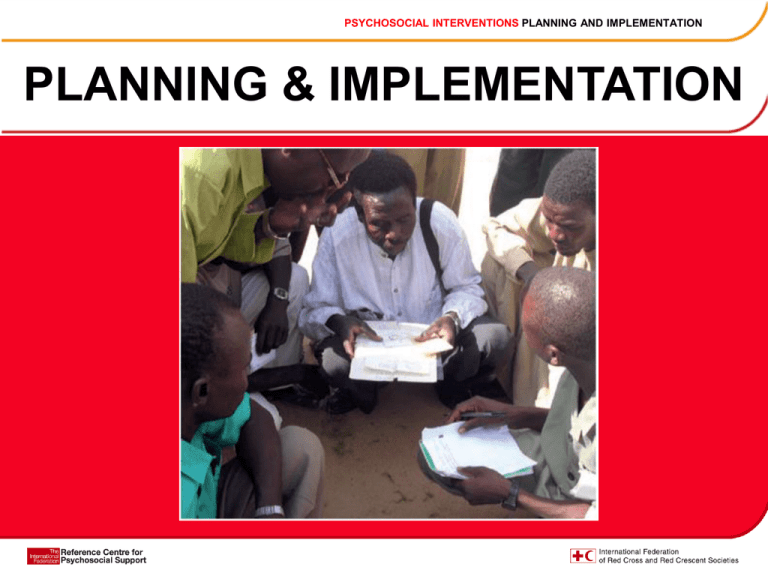
PSYCHOSOCIAL INTERVENTIONS PLANNING AND IMPLEMENTATION PLANNING & IMPLEMENTATION PSYCHOSOCIAL INTERVENTIONS PLANNING AND IMPLEMENTATION Focus of this workshop session Part A When do you start planning a PS response? Who is involved in a psychosocial response? Choosing the target group Choosing the right activities Activity examples PSYCHOSOCIAL INTERVENTIONS PLANNING AND IMPLEMENTATION Focus of this workshop session Part B Programme management Plannning and implementing Flexibility Human resources Partnerships and relationships Advocacy and information dissemination PSYCHOSOCIAL INTERVENTIONS PLANNING AND IMPLEMENTATION When do you start planning a PS response? PSYCHOSOCIAL INTERVENTIONS PLANNING AND IMPLEMENTATION Preparations for psychosocial response Training • Staff • Volunteers • Community members Advocacy • Organizational (budget) • Public (Awareness, Sensitization) • National PSYCHOSOCIAL INTERVENTIONS PLANNING AND IMPLEMENTATION When does planning a PS response start? PSYCHOSOCIAL INTERVENTIONS PLANNING AND IMPLEMENTATION Who is involved in a psychosocial response? Who is the most important group of people in a PS response? The affected population = community What is a community? A group of people who - Live in an area together or - Have similar backgrounds, religious beliefs, jobs, interests etc. PSYCHOSOCIAL INTERVENTIONS PLANNING AND IMPLEMENTATION Community participation Why is participation of the affected community important for a psychosocial response? The affected population know best • How they have been affected • Which people or groups are affected in different ways • How they are coping with the impact of the event now • What help they need to cope better • Appropriate social and cultural behaviour PSYCHOSOCIAL INTERVENTIONS PLANNING AND IMPLEMENTATION Community participation What can the community participate in? • Assessing needs • Planning activities, inputs to drafting proposals • Implementing activities • Mobilizing others • Monitoring and evaluation PSYCHOSOCIAL INTERVENTIONS PLANNING AND IMPLEMENTATION Community participation Psychosocial benefits Response = relevant = realistic Affected population take responsibility for own recovery Opportunities for capacity building • Socially and culturally appropriate • Increases community ‘togetherness’ and peer support • Increases sense of empowerment and achievement • • • • Participation in data collection and analysis Training on psychosocial support Provision of psychosocial support Referral mechanism PSYCHOSOCIAL INTERVENTIONS PLANNING AND IMPLEMENTATION Volunteers • RCRC Movement is volunteer-based • Volunteers = invaluable resource PSYCHOSOCIAL INTERVENTIONS PLANNING AND IMPLEMENTATION Volunteers • May be directly affected by disaster • Likely to be emotionally affected by working with psychosocial interventions • Care and support for staff and volunteers = important program component PSYCHOSOCIAL INTERVENTIONS PLANNING AND IMPLEMENTATION Who is involved in a psychosocial response? Program staff Other sectors same organization Volunteers Affected population Planning and implementing Psychosocial intervention Other organizations/ bodies PSYCHOSOCIAL INTERVENTIONS PLANNING AND IMPLEMENTATION How do you choose your target group? In groups of 4 discuss this question for 10 minutes and then present your findings to plenary PSYCHOSOCIAL INTERVENTIONS PLANNING AND IMPLEMENTATION How do you choose your target group? • Coordinate • Assess vulnerability • Find the ‘hard to reach’ • Be realistic • Referrals • Advocate PSYCHOSOCIAL INTERVENTIONS PLANNING AND IMPLEMENTATION Holistic and integrated approach PSYCHOSOCIAL INTERVENTIONS PLANNING AND IMPLEMENTATION Choosing activities Initial activities Assessments + Psychological First Aid Community mobilization Involvement in assessments; Identifying vulnerable groups; Mobilizing others Realistic and meaningful activities Balance between needs and resources; short term or long term impact; target groups PSYCHOSOCIAL INTERVENTIONS PLANNING AND IMPLEMENTATION Relevant activities change with time PSYCHOSOCIAL INTERVENTIONS PLANNING AND IMPLEMENTATION Examples of activities in a PS response Preparations Capacity building • Disaster Preparedness • Assessments • Coordination (e.g. basic needs) • Capacity building • Initial training in PFA/Assessments • PS specific training • Program management tasks Psychoeducation Advocacy • Development / distribution of IEC materials • Public performances (e.g. drama) • Advocacy local / national Program management • Assessments • Community mobilization / contact • Coordination (internal and external) PSYCHOSOCIAL INTERVENTIONS PLANNING AND IMPLEMENTATION Examples of psychosocial activities Emergency: 0-6 months • Psychological First Aid • Support groups • Burial ceremonies • Grieving rituals • Distribution of PS support items • Family tracing • Community restoration PSYCHOSOCIAL INTERVENTIONS PLANNING AND IMPLEMENTATION Examples of psychosocial activities Recovery / development: 3 months to 1-3 yrs • Children’s / youth clubs • Formal/informal schooling • Life skills activities • Collective memorial ceremonies • Livelihood activities • Disaster preparedness training; Risk reduction training; Building community resilience PSYCHOSOCIAL INTERVENTIONS PLANNING AND IMPLEMENTATION Examples of psychosocial activities Conflict situations • Peer support groups • Reintegration of child soldiers • Tailored workshops with children and adults • Education and training in non-violent conflict resolution • School-based activities PSYCHOSOCIAL INTERVENTIONS PLANNING AND IMPLEMENTATION Examples of psychosocial activities Health emergencies • Home-based care (HIV, OVC) • Memory Work • Hero Books • Coping with losing loved ones • Will writing • School-based PSYCHOSOCIAL INTERVENTIONS PLANNING AND IMPLEMENTATION Examples of psychosocial activities Individual and community recovery / resilience building Group work: Make a list of the kinds of activities that will help 1. 2. 3. 4. 5. Individuals (all) Elderly Children People living with disabilities Whole communities recover from a disaster event, and build resilience in the face of new disasters (cope better if it happens again) PSYCHOSOCIAL INTERVENTIONS PLANNING AND IMPLEMENTATION Examples of psychosocial activities Individual and community recovery / resilience building Important considerations • Gender and age • Religious affiliation Men Disabilities Elderly Community activities • Child protection Women Children Boys Girls PSYCHOSOCIAL INTERVENTIONS PLANNING AND IMPLEMENTATION Protecting and working with children • Increased risks of abuse and violence – especially if unaccompanied • Should be empowered with knowledge to stop and/or report incidences of abuse • Special attention on younger children and Early Childhood Development • Follow all ethical guidelines on working with children PSYCHOSOCIAL INTERVENTIONS PLANNING AND IMPLEMENTATION Time for an energizer!! PSYCHOSOCIAL INTERVENTIONS PLANNING AND IMPLEMENTATION Part B: PS Program management Goals/aims Activity outcomes Activity outputs Immediate objectives Activity Inputs PSYCHOSOCIAL INTERVENTIONS MONITORING AND EVALUATION Logical framework approach Indicators Overall Goal To reduce suffering and risk for development of severe trauma of Population A Adults and children show healthy signs of coping with impact of crisis event Activity 1 Training in PFA Input Resources to enable training Amount of money; personnel; training manuals; materials Output Training has taken place Number of people trained Outcome Volunteers can provide PFA Skill level in PFA has increased Activity 2: Workshops with children Input Resources for workshops Amount of money; personnel; training manuals; materials Output Workshops are held Number of workshops held; number of children attended; number of trainers Outcome Children are coping better Increase in children’s playfulness, self-confidence, trusting of others PSYCHOSOCIAL INTERVENTIONS PLANNING AND IMPLEMENTATION Psychosocial program management How is managing a psychosocial program different from managing any other kind of program? Consider: • Changing needs of population during implementation period PSYCHOSOCIAL INTERVENTIONS PLANNING AND IMPLEMENTATION Budget expenditure Changing needs of population during implementation period PSYCHOSOCIAL INTERVENTIONS PLANNING AND IMPLEMENTATION Flexibility • Changing needs of population during implementation period (budget, human resources) • Importance of community participation (budget, timing) Anticipate fluctuations and adaptations to budgets and time-planning – avoid PROGRAM LOCKING!!! PSYCHOSOCIAL INTERVENTIONS PLANNING AND IMPLEMENTATION Human Resources • Training needs – staff and volunteers • Supervision • Retention PSYCHOSOCIAL INTERVENTIONS PLANNING AND IMPLEMENTATION Partnerships and relationships Political and social safety Education Psychosocial wellbeing Physical health Basic needs PSYCHOSOCIAL INTERVENTIONS PLANNING AND IMPLEMENTATION Partnerships and relationships Internal partners External partners Community • Other sectors within National Society • E.g. Food and nutrition, shelter • Government – local / national • Other organizations • Faith-based • Other NGO’s PSYCHOSOCIAL INTERVENTIONS PLANNING AND IMPLEMENTATION Advocacy and information dissemination Why do we need to advocate for attention to PS needs and responses? To motivate development of national policies and guidelines Quality assurance To ensure budget allocation in national and organizational budgets Quality assurance; Assurance of reach Ultimately ensure provision of psychosocial support and to improve PSWB PSYCHOSOCIAL INTERVENTIONS PLANNING AND IMPLEMENTATION Advocacy and information dissemination Critical component of advocacy is: • raising awareness • sharing information How do you do this? Documentation and sharing of information and IEC materials
